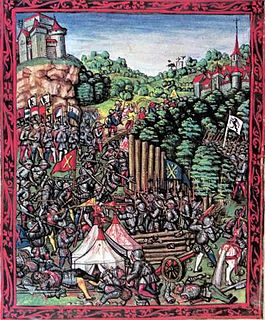 W
WThe Swabian War of 1499 was the last major armed conflict between the Old Swiss Confederacy and the House of Habsburg. What had begun as a local conflict over the control of the Val Müstair and the Umbrail Pass in the Grisons soon got out of hand when both parties called upon their allies for help; the Habsburgs demanding the support of the Swabian League, and the Federation of the Three Leagues of the Grisons turning to the Swiss Eidgenossenschaft. Hostilities quickly spread from the Grisons through the Rhine valley to Lake Constance and even to the Sundgau in southern Alsace, the westernmost part of Habsburg Further Austria.
 W
WThe Battle of Bruderholz took place on 22 March 1499 in the Swabian War between Swabian troops and forces of the Old Swiss Confederacy. The Swabians had raided several Swiss villages and were on their way back when they met troops from Lucerne, Solothurn, and Berne, who also came back from a raid in the Alsace. At the Bruderholz, a hill south of Basel, the Swiss engaged the three times more numerous Swabians in battle and defeated them.
 W
WThe Battle of Calven took place on May 22, 1499 at the exit of the Val Müstair in the Grisons to the Vinschgau in County of Tyrol between the forces of King Maximilian I of the House of Habsburg and those of the free federation of the Three Leagues of the Grisons. It was the decisive battle in the southern Grisons of the Swabian War; after the defeat of the Habsburg troops, the king had to abandon his attempts to control the Engadin and the Val Müstair. The focus of operations in the Swabian War subsequently shifted again to the northern border of the Old Swiss Confederacy.
 W
WThe Battle of Dornach was a battle fought on 22 July 1499 between the troops of Emperor Maximilian I and the Old Swiss Confederacy close to the Swiss village of Dornach. The battle turned into a decisive defeat for Maximilian, and concluded the Swabian War between the Swiss and the Swabian League.
 W
WThe Battle of Frastanz between an army of the Old Swiss Confederacy and the troops of King Maximilian I of the Holy Roman Empire took place on 20 April 1499. In one of the many raids of the Swabian War, an expedition of Habsburg troops had plundered some villages in the Swiss Confederacy, who responded by sending an army to Vorarlberg. At Frastanz, a few kilometers south-east of Feldkirch, the Habsburg troops had blocked the entry to the Montafon valley with a strong wooden fortification called a Letzi. The Swiss used a flanking maneuver to bypass the Letzi and after a hard battle routed Maximilian's army. Many Landsknechte drowned in the river Ill.
 W
WThe Battle of Hard was the first large-scale battle in the Swabian War, waged between the Imperials under the Holy Roman Emperor Maximilian I and the Swiss Confederates. The battle was fought on 20 February 1499, a cold and foggy day, between 10,000 Imperial troops, mostly from the Swabian Circles, and a smaller number of Swiss troops, often called Reisläufer.
 W
WThe Battle of Schwaderloh took place on April 11, 1499 near Triboltingen, a village on the Swiss shores of the Untersee just south of Constance. It was one of the major battles of the Swabian War between the Old Swiss Confederacy and the forces of the Swabian League and of Emperor Maximilian I.
 W
WThe Treaty of Basel of 22 September 1499 was an armistice following the Battle of Dornach, concluding the Swabian War, fought between the Swabian League and the Old Swiss Confederacy.